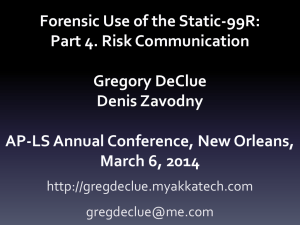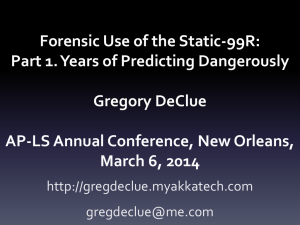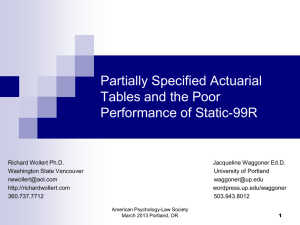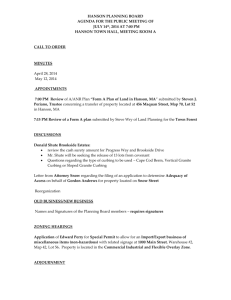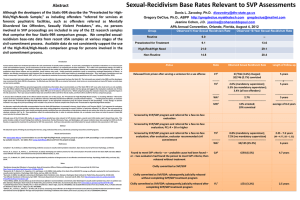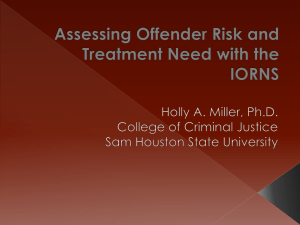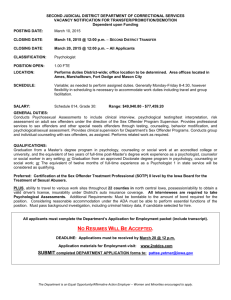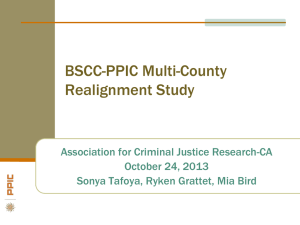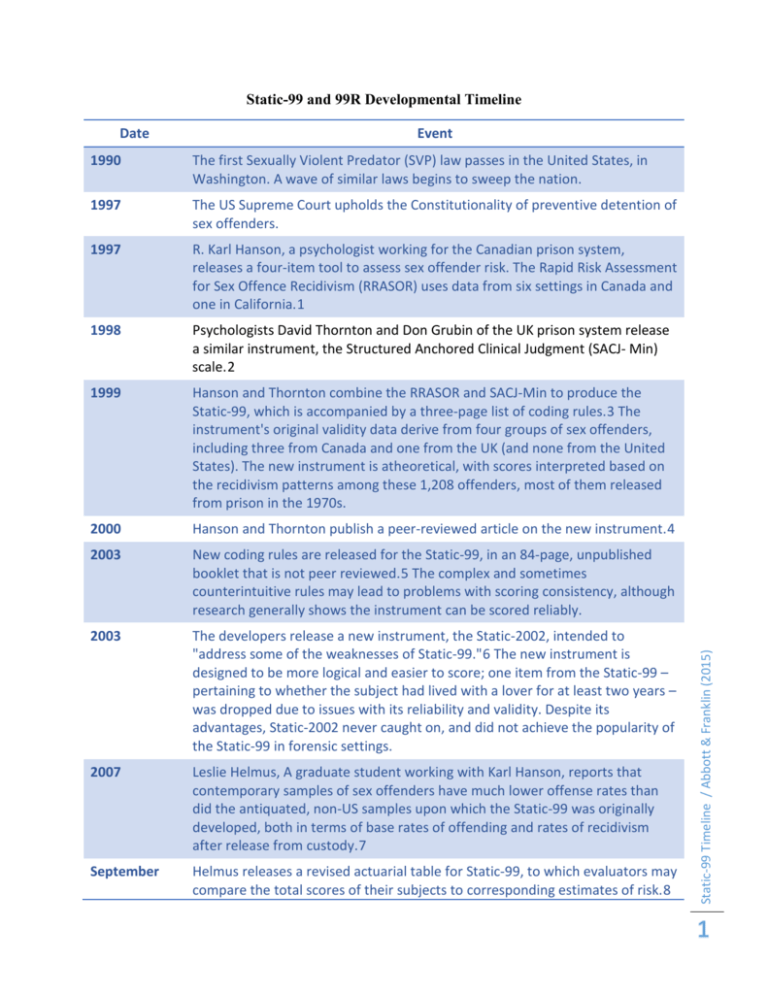
Static-99 and 99R Developmental Timeline
Event
1990
The first Sexually Violent Predator (SVP) law passes in the United States, in
Washington. A wave of similar laws begins to sweep the nation.
1997
The US Supreme Court upholds the Constitutionality of preventive detention of
sex offenders.
1997
R. Karl Hanson, a psychologist working for the Canadian prison system,
releases a four-item tool to assess sex offender risk. The Rapid Risk Assessment
for Sex Offence Recidivism (RRASOR) uses data from six settings in Canada and
one in California.1
1998
Psychologists David Thornton and Don Grubin of the UK prison system release
a similar instrument, the Structured Anchored Clinical Judgment (SACJ- Min)
scale.2
1999
Hanson and Thornton combine the RRASOR and SACJ-Min to produce the
Static-99, which is accompanied by a three-page list of coding rules.3 The
instrument's original validity data derive from four groups of sex offenders,
including three from Canada and one from the UK (and none from the United
States). The new instrument is atheoretical, with scores interpreted based on
the recidivism patterns among these 1,208 offenders, most of them released
from prison in the 1970s.
2000
Hanson and Thornton publish a peer-reviewed article on the new instrument.4
2003
New coding rules are released for the Static-99, in an 84-page, unpublished
booklet that is not peer reviewed.5 The complex and sometimes
counterintuitive rules may lead to problems with scoring consistency, although
research generally shows the instrument can be scored reliably.
2003
The developers release a new instrument, the Static-2002, intended to
"address some of the weaknesses of Static-99."6 The new instrument is
designed to be more logical and easier to score; one item from the Static-99 –
pertaining to whether the subject had lived with a lover for at least two years –
was dropped due to issues with its reliability and validity. Despite its
advantages, Static-2002 never caught on, and did not achieve the popularity of
the Static-99 in forensic settings.
2007
Leslie Helmus, A graduate student working with Karl Hanson, reports that
contemporary samples of sex offenders have much lower offense rates than
did the antiquated, non-US samples upon which the Static-99 was originally
developed, both in terms of base rates of offending and rates of recidivism
after release from custody.7
September
Helmus releases a revised actuarial table for Static-99, to which evaluators may
compare the total scores of their subjects to corresponding estimates of risk.8
Static-99 Timeline / Abbott & Franklin (2015)
Date
1
Another Static-99 developer, Amy Phenix, releases the first of several
"Evaluators’ Handbooks."9
October 2008
At an annual convention of the Association for the Treatment of Sexual
Abusers (ATSA), Andrew Harris, a Canadian colleague of Hanson's, releases a
new version of the Static-99 with three separate "reference groups"
(Complete, CSC and High Risk) to which subjects can be compared. Evaluators
are instructed to report a range of risks for recidivism, with the lower bound
coming from a set of Canadian prison cases (the so-called CSC, or Correctional
Service of Canada group), and the upper bound derived from a so-called "highrisk" group of offenders. The risk of the third, or "Complete," group was
hypothesized as falling somewhere between those of the other two groups.10
November
2008
At a workshop sponsored by a civil commitment center in Minnesota,
Thornton and a government evaluator named Dennis Doren propose yet
another new method of selecting among the new reference groups. In a
procedure called "cohort matching,” they suggest comparing an offender with
either the CSC or High-Risk reference group based on how well the subject
matched a list of external characteristics they had created but never
empirically tested or validated.11
December
2008
Phenix and California psychologist Dale Arnold put forth yet a new idea for
improving the accuracy of the Static-99: After reporting the range of risk based
on a combination of the CSC and High-Risk reference groups, evaluators are
encouraged to consider a set of external factors, such as whether the offender
had dropped out of treatment and the offender's score on Robert Hare's
controversial Psychopathy Checklist-Revised (PCL-R). This new method does
not seem to catch on.12 13
2009
An official Static-99 website, www.static99.org, debuts.14
Winter 2009
The Static-99 developers admit that norms they developed in 2000 are not
being replicated: The same score on the Static-99 equates with wide variations
in recidivism rates depending on the sample to which it is compared. They
theorize that the problem is due to large reductions in Canadian and U.S.
recidivism rates since the 1970s-1980s. They call for the development of new
norms.15
September
2009
Hanson and colleagues roll out a new version of the Static-99, the Static99R.16 The new instrument addresses a major criticism by more precisely
considering an offender's age at release, an essential factor in reoffense risk.
The old Static-99 norms are deemed obsolete. They are replaced by data from
23 samples collected by Helmus for her unpublished Master's thesis. The
samples vary widely in regard to risk. For estimating risk, the developers now
recommend use of the cohort matching procedure to select among four new
reference group options. They also introduce the concepts of percentile ranks
and relative risk ratios, along with a new Evaluators’ Workbook for Static-99R
Static-99 Timeline / Abbott & Franklin (2015)
2008
2
November
2009
Just two months after their introduction, the Evaluators’ Workbook for Static99R and Static-2002R is withdrawn due to errors in its actuarial tables.18 The
replacement workbook provides the same confusing and speculative method
for selecting a nonroutine reference group, a method that lacks scientific
validation and reliability.
2010
An international team of researchers presents large-scale data from the United
States, New Zealand and Australia indicating that the Static-99 would be more
accurate if it took better account of an offender's age.19 The Static-99
developers do not immediately embrace these researchers' suggestions.
January 2012
Amy Phenix and colleagues introduce a revised Evaluators’ Workbook for
Static-99R and Static-2002R.20 The new manual makes a number of revisions
both to the underlying data (including percentile rank and relative risk ratio
data) and to the recommended procedure for selecting a reference group.
Now, in an increasingly complex procedure, offenders are to be compared to
one of three reference groups, based on how many external risk factors they
had. The groups included Routine Corrections (low risk), Preselected
Treatment Need (moderate risk), and Preselected High Risk Need (high risk).
Subsequent research shows that using density of external risk factors to select
among the three reference group options is not valid and has no proven
reliability.21A fourth reference group, Nonroutine Corrections, may be
selected using a separate cohort-matching procedure. New research indicates
that evaluators who are retained most often by the prosecution are more likely
than others to select the high-risk reference group, 22 which has base rates
much higher than in contemporary sexual recidivism studies and will thus
produce exaggerated risk estimates.23
July 2012
Six months later, the percentile ranks and relative risk ratios are once again
modified, with the issuance of the third edition of the Static-99R and Static2002R Evaluators’ Handbook.24 No additional data is provided to justify that
the selection of nonroutine reference groups produces more accurate risk
estimates than choosing the routine corrections reference group.
October 2012
In an article published in Criminal Justice & Behavior, the developers concede
that risk estimates for the 23 offender samples undergirding the Static-99 vary
widely. Further, absolute risk levels for typical sex offenders are far lower than
previously reported, with the typical sex offender having about a 7% chance of
committing a new sex offense within five years. They theorize that the Static99 might be inflating risk of reoffense due to the fact that the offenders in its
underlying samples tended to be higher risk than average.25
Static-99 Timeline / Abbott & Franklin (2015)
and Static-2002R. Instructions for selecting reference groups other than
routine corrections are confusing and speculative. Research is lacking to
demonstrate that selecting other than routine corrections reference group
produces more accurate risk estimates.17
3
The repeated refusal of the Static-99 developers to share their underlying data
with other researchers, so that its accuracy can be verified, leads to a court
order excluding use of the instrument in a Wisconsin case.26
October 2013
At an annual ATSA convention, Hanson and Phenix report that an entirely new
reference group selection system will be released in a peer-reviewed article in
Spring 2014.27 The new system will include only two reference groups:
Routine Corrections and Preselected High Risk High Need. An atypical sample
of offenders from a state hospital in Bridgewater, Massachusetts dating back
to 1958 is to be removed altogether, along with some other samples, while
some new data sets are to be added.
October 2014
At the annual ATSA convention, the developers once again announce that the
anticipated rollout of the new system has been pushed back pending
acceptance of the manuscript for publication. Helmus nonetheless presents an
overview.28 She reports that the new system will abandon two out of the
current four reference groups, retaining only Routine Corrections and
Preselected High Risk Need. Evaluators should now use the Routine
Corrections norms as the default unless local norms (with a minimum of 100
recidivists) are available. Evaluators will be permitted to choose the
Preselected High Risk Need norms based on “strong, case-specific
justification.” No specific guidance nor empirical evidence to support such a
procedure is proffered. A number of other new options for reporting risk
information are also presented, including the idea of combining Static-99 data
with that from newly developed, so-called "dynamic risk instruments."
At an ATSA convention presentation followed by an article in the journal Sexual
Abuse, 29 the developers announce further changes in their data sets and how
Static-99R scores should be interpreted. Only two of the original four
"reference groups" are still standing. Of these, the Routine group has grown by
80% (to 4,325 subjects), while the High-Risk group has shrunk by 35%, to a
paltry 860 individuals. Absent from the article is any actuarial table on the
High-Risk group, meaning the controversial practice by some government
evaluators of inflating risk estimates by comparing sex offenders' Static-99R
scores with the High-Risk group data has still not passed any formal peer
review process. The developers also correct a previous statistical method as
recommended by Ted Donaldson and colleagues back in 2012, 30 the effect of
which is to further lower risk estimates in the high-risk group. Only sex
offenders in the Routine group with Static-99R scores of 10 are now
statistically more likely than not to reoffend. It is unknown how many sex
offenders were civilly committed in part due to reliance on the now-obsolete
data.
January 2015
Static-99 Timeline / Abbott & Franklin (2015)
2012
4
References
1
Hanson, R. K. (1997). The development of a brief actuarial risk scale for sexual offense recidivism.
(Unpublished report 97-04). Ottawa: Department of the Solicitor General of Canada.
2
Grubin, D. (1998). Sex offending against children: Understanding the risk. Unpublished report, Police
Research Series Paper 99. London: Home Office.
3
Hanson, R.K. & Thornton, D. (1999). Static 99: Improving Actuarial Risk Assessments for Sex Offenders.
Unpublished paper
4
Hanson, R. K., & Thornton, D. (2000). Improving risk assessments for sex offenders: A comparison of
three actuarial scales. Law and Human Behavior, 24(1), 119-136.
5
Harris, A. J. R., Phenix, A., Hanson, R. K., & Thornton, D. (2003). Static-99 coding rules: Revised 2003.
Ottawa, ON: Solicitor General Canada.
6
Hanson, R.K., Helmus, L., & Thornton, D (2010). Predicting recidivism amongst sexual offenders: A
multi-site study of Static-2002. Law & Human Behavior 34, 198-211.
7
Helmus, L. (2007). A multi-site comparison of the validity and utility of the Static-99 and Static-2002 for
risk assessment with sexual offenders. Unpublished Honour’s thesis, Carleton University, Ottawa, ON,
Canada.
8
Helmus, L. (2008, September). Static-99 Recidivism Percentages by Risk Level. Last Updated September
25, 2008. Unpublished paper.
9
Phenix, A., Helmus, L., & Hanson, R.K. (2008, September). Evaluators’ Workbook. Unpublished,
September 28, 2008
10
Harris, A. J. R., Hanson, K., & Helmus, L. (2008). Are new norms needed for Static-99? Workshop
presented at the ATSA 27th Annual Research and Treatment Conference on October 23, 2008, Atlanta:
GA. Available at www.static99.org.
11
Doren, D., & Thornton, D. (2008). New Norms for Static-99: A Briefing. A workshop sponsored by Sand
Ridge Secure Treatment Center on November 10, 2008. Madison, WI.
Phenix, A. & Arnold, D. (2008, December). Proposed Considerations for Conducting Sex Offender Risk
Assessment Draft 12-14-08. Unpublished paper.
13
Abbott, B. (2009). Applicability of the new Static-99 experience tables in sexually violent predator risk
assessments. Sexual Offender Treatment, 1, 1-24.
14
Helmus, L., Hanson, R. K., & Thornton, D. (2009). Reporting Static-99 in light of new research on
recidivism norms. The Forum, 21(1), Winter 2009, 38-45.
15
Ibid.
16
Hanson, R. K., Phenix, A., & Helmus, L. (2009, September). Static-99(R) and Static-2002(R): How to
Interpret and Report in Light of Recent Research. Paper presented at the 28th Annual Research and
Treatment Conference of the Association for the Treatment of Sexual Abusers, Dallas, TX, September 28,
2009.
17
DeClue, G. & Zavodny, D. (2014). Forensic use of the Static-99R: Part 4. Risk Communication. Journal
of Threat Assessment and Management, 1(3), 145-161.
Static-99 Timeline / Abbott & Franklin (2015)
12
5
18
Phenix, A., Helmus, L., & Hanson, R.K. (2009, November). Evaluators’ Workbook. Unpublished,
November 3, 2009.
19
Wollert, R., Cramer, E., Waggoner, J., Skelton, A., & Vess, J. (2010). Recent Research (N = 9,305)
Underscores the Importance of Using Age-Stratified Actuarial Tables in Sex Offender Risk Assessments.
Sexual Abuse: A Journal of Research and Treatment, 22 (4), 471-490. See also: "Age tables improve sex
offender risk estimates," In the News blog, Dec. 1, 2010.
20
Phenix, A., Helmus, L., & Hanson, R.K. (2012, January). Evaluators’ Workbook. Unpublished, January 9,
2012.
21
Abbott, B.R. (2013). The Utility of Assessing “External Risk Factors” When Selecting Static-99R
Reference Groups. Open Access Journal of Forensic Psychology, 5, 89-118.
22
Chevalier, C., Boccaccini, M. T., Murrie, D. C. & Varela, J. G. (2014), Static-99R Reporting Practices in
Sexually Violent Predator Cases: Does Norm Selection Reflect Adversarial Allegiance? Law & Human
Behavior. To request a copy from the author, click HERE.
23
Abbott (2013) op. cit.
24
Phenix, A., Helmus, L., & Hanson, R.K. (2012, July). Evaluators’ Workbook. Unpublished, July 26, 2012.
25
Helmus, Hanson, Thornton, Babchishin, & Harris (2012), Absolute recidivism rates predicted by Static99R and Static-2002R sex offender risk assessment tools vary across samples: A meta-analysis, Criminal
Justice & Behavior. See also: "Static-99R risk estimates wildly unstable, developers admit," In the News
blog, Oct. 18, 2012.
26
State of Wisconsin v. Homer L. Perren Jr., La Crosse County 2010-CI000003. See Franklin, K. "Judge
bars Static-99R risk tool from SVP trial: Developers staunchly refused requests to turn over data" (2012,
Dec. 14), In the News blog.
27
Hanson, R.K. & Phenix, A. (2013, October). Report writing for the Static-99R and Static-2002R.
Preconference seminar presented at the 32nd Annual Research and Treatment Conference of the
Association for the Treatment of Sexual Abusers, Chicago, IL, October 30, 2013. See also: "Static-99
'norms du jour' get yet another makeover," In the News blog, Nov. 17, 2013.
Helmus, L.M. (2014, October). Absolute recidivism estimates for Static-99R and Static-2002R: Current
research and recommendations. Paper presented at the 33rd Annual Research and Treatment
Conference of the Association for the Treatment of Sexual Abusers, San Diego, CA, October 30, 2014.
29
Hanson, R. K., Thornton, D., Helmus, L-M, & Babchishin, K. (2015). What sexual recidivism rates are
associated with Static-99R and Static-2002R scores? Sexual Abuse: A Journal of Research and Treatment,
1-35.
30
Donaldson, T., Abbott, B., & Michie, C. (2012). Problems with the Static-99R prediction
estimates and confidence intervals. Open Access Journal of Forensic Psychology, 4, 1-23.
© 2015 by Brian Abbott and Karen Franklin. All rights reserved.
Static-99 Timeline / Abbott & Franklin (2015)
28
6

